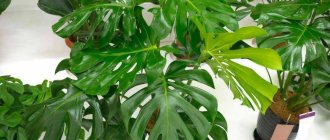Monstera was introduced to European countries several centuries ago, and since then debates about its safety for human health have not subsided. There are many signs about this plant that highlight not only its negative properties, but also its positive qualities. We suggest you find out whether it is possible to keep a monstera at home or is it better to refuse such a green pet.
Most superstitions associated with Monstera insist that it is better not to keep it at home.
Monstera - can you keep it at home?
Most superstitions associated with Monstera insist that it is better not to keep it at home, and there are reasons for this.
- People say that you should not place Monstera in the bedroom. This plant has wide leaves that absorb large amounts of oxygen and release carbon dioxide. It is believed that because of this, a person may feel an attack of suffocation during sleep. This statement has no scientific explanation. Only one thing is known: not a single indoor flower is capable of this. Some amount of carbon dioxide is indeed released, but its share is small and cannot lead to suffocation.
- Another sign calls this plant a muzhegon, and therefore does not advise girls to have it. Otherwise, the young lady will not meet her soulmate and will remain lonely.
- If you turn to the signs of other nationalities, you can get a completely opposite result. For example, in Asia, the monstera is perceived as a talisman that brings good luck to its owner. Local residents are confident that the plant will help maintain good health and improve their financial situation.
- People have learned to determine the weather based on their behavior. And if the leaves of the plant begin to intensively secrete juice, which collects in large, clearly visible drops, it will soon rain.
In Asia, the monstera is perceived as a talisman that brings good luck to its owner.
Popular beliefs
Here are the most popular ones:
- Monstera is an energy vampire and sucks the strength out of a person, thereby destroying his life and spoiling his health. It can also suck energy from pets.
- The plant should never be placed near the bed - it can cause suffocation, nightmares and even death.
- Monstera disrupts harmony in the family , which is why spouses will constantly quarrel, which can even lead to the destruction of the marriage.
- Monstera should not be kept in a house where an unmarried girl or woman lives - this flower repels men and prevents her from having a serious relationship.
Benefits and harms
According to a common version, if you keep a monstera in an apartment, it will deprive its inhabitants of vital energy. When there is peace and tranquility in the house, the monstera will try to influence the situation, and not in the best way: it will absorb positive energy and give back negative energy in return.
People say that this tropical plant receives negative energy from household members when they are in conflict: during a quarrel, the monstera begins to intensively absorb a negative charge. And here this property is positive. But as soon as there is a lull, the monstera immediately tries to break it, filling the room with streams of negativity.
However, this harmful quality can be used to your advantage. To do this, place the flower pot in the place where it is necessary to reduce the harmful effects of radiation, for example, near a TV or microwave oven.
In fact, Monstera has many more positive qualities than negative ones.
- Produces oxygen, which is necessary for the normal functioning of the body of every person.
- Enriches the air with ions, humidifies it and absorbs microparticles that pollute it.
- Suppresses the growth of harmful microorganisms, bacteria and viruses.
- Absorbs electromagnetic radiation in the room.
- Absorbs formaldehyde contained in chemical industry products.
- Monstera actively exhibits its beneficial properties during the flowering period.
Distribution area
Natural habitat - Southern Mexico, tropical forests of Brazil and Guiana.
In addition, in the 19th century it was introduced into Southeast Asia. In wild jungle conditions, its height can reach 30 meters. The long aboveground stem usually twines around tall trees, attaching to the trunk with the help of adventitious aerial roots. When grown in artificial conditions, it has a more modest size - in greenhouses it can reach a size of about 10 meters, in apartments - a maximum of 5.
Leaves
The leaves are large (up to 0.5 meters in diameter), round in shape, pointed at the ends with long flexible cuttings. The leaf plate is dark green in color and covered with slots of different shapes and sizes over the entire surface. The leaves of young representatives of the species are entire and heart-shaped. After reaching a size of 10 cm, deep cuts begin to appear on them.
Roots
The root system consists of a large number of aerial and adventitious roots. The seeds usually germinate in the bark of large trees, on which it grows slowly, like an epiphyte. As it grows, long aerial roots are produced from the base of the main stem, several from each large leaf. Having reached the earthen surface, they bend and produce lateral roots covered with small root hairs.
When the roots become stronger in the ground, the vine begins to grow quickly, twining along the tree on which it sprouted.
Flowers and fruits
The flowering process occurs annually. The flowers are small, bisexual, united in the shape of a spadix, and are formed at the nodes. The color of the buds is white or beige, the core is yellow and has a cylindrical shape. Fruit ripening time is 10 – 14 months. The fruits are edible and have the shape of a cob. The fruits are called berries.
When grown indoors, it is almost impossible to create favorable conditions for flowering. Therefore, almost all photos of flowering vines were taken in natural conditions.
The influence of a flower on a person
Esotericists agree that monstera is capable of absorbing energy. This explains why a person feels weak in the morning if this plant is in his bedroom. However, it is worth noting that people with sensitivity to changes in energy flows are susceptible to this influence.
There is also an opposite opinion, according to which, if you keep this indoor flower at home, it will help improve your well-being. Monstera relieves headaches and prevents the development of diseases during the cold season. Moreover, such an effect on humans is obvious, especially if we take into account such properties of the plant as ionization and air purification.
Possible difficulties of cultivation
Monstera can be affected by the following pests:
- Mealybugs form “cotton” lumps, which are most often located on the lower plate of the leaf or in its axils. The leaves of the affected plant turn yellow and growth stops. Monstera is isolated and treated with drugs against sucking pests every 4-5 days;
- Spider mites also live on the underside of leaves. Its presence is indicated by light green spots, which merge after a while, the leaf turns yellow and falls off. The drug Fitoverm is used for treatment. And for prevention, high humidity is necessary.
Important! Liana does not like frequent rearrangement and touching. Therefore, do not disturb her too often unless absolutely necessary. If improperly cared for, the tropical beauty may experience the following problems:
If not properly cared for, the tropical beauty may experience the following problems:
- Losing leaves is a natural process, but if more leaves are lost than grown, then this is not normal. This may be caused by a lack of light or nutrition;
- Yellowing leaves indicate a lack of nutrition. Their decay is the result of waterlogging;
- if the leaf plate becomes brown and “papery”, then a larger container or higher humidity is needed;
- leaves turn pale from too much light;
- Stretching of the stem and shrinking of leaves causes a lack of lighting;
- A solid leaf plate without slits occurs when there is a lack of fertilizing or light.
Monstera according to Feng Shui
If we turn to the teachings of Feng Shui, it says that Monstera is an amazing plant that can equalize the energy in any space. By combining Yin and Yang, the flower creates an atmosphere of comfort and harmony. Moreover, it can be placed in the kitchen, in the living room, and in the hallway.
As for the bedroom, it is considered not the most suitable place for a monstera. If the plant is placed in this room, it will negatively affect the relationship between spouses. The connection between them will begin to weaken, and soon they may completely cool off towards each other.
It’s good if you can allocate a place for Monstera in your office. Thanks to it, efficiency will increase, thoughts will be more orderly, a person will begin to show determination in business and bring what he started to the end.
Monstera is an amazing plant that can even out energy in any space.
Is Monstera poisonous or not?
There is a version that monstera is a poisonous plant. To some extent, this statement is true. The fact is that the fruits and leaves contain a substance that, upon contact with the skin, can provoke the development of an allergic reaction. It usually manifests itself in the form of irritation. If this substance gets on the mucous membranes, serious damage may occur.
It is clear that an adult will not taste any parts of an indoor flower, and therefore the danger of its juice is automatically reduced to zero. However, it is worth remembering that if there are pets in the apartment, they may well chew the leaves. And such a situation is quite capable of causing harm.
The same applies to small children. Babies, as a rule, try to taste the objects around them, without understanding whether they are edible or not. Therefore, it is important to be vigilant.
What does it symbolize
In the East, this flower symbolizes longevity, good luck and good health. Along with anthurium and dieffenbachia, monstera is one of the most popular representatives of the araceae family.
A powerful vine with large leathery leaves with spectacular slits. At home, it grows up to 2-4 m and lives up to 15-20 years.
Its name translates as “bizarre” and “amazing”, and not “monstrous”, as is sometimes mistakenly believed.
People are often afraid of the impressive size of the plant, which is what most negative superstitions are associated with. However, Eastern sages consider it a protector from many misfortunes - physical, chemical and energy.
Monstera in the office - signs
According to superstitions, this plant helps improve concentration. And for this reason, it is recommended to grow it in offices and other similar public places. It happens that with a large crowd of people, it is quite difficult to concentrate on your task. And the presence of monstera in this case will be very useful.
It will enrich the air with oxygen, catch all the dust with its lush leaves, which will improve brain activity. In addition, such an atmosphere helps to cope with stress more easily and relieves tension.
If you are busy developing your business, Monstera will help here too. By quickly making important decisions, you can easily find a way out of any current situation and learn how to negotiate correctly. As a result, you will be provided with support from reliable partners.
This plant helps improve concentration
Dispelling popular myths
Monstera, an inhabitant of humid subtropics, reaches gigantic sizes in natural conditions. This large vine grows up to 40 meters or more in length, twining around tall trees. Additional long roots grow on its trunks, which can hang all the way to the ground, entwining and growing through everything that gets in their way.
In past centuries, travelers in South America often found monstera thickets in the jungle, next to which lay the skeletons of people and animals, riddled with the roots of these plants. The sight was terrible. In fact, these were the remains of those who accidentally died not far from these thickets, and the roots then grew through everything that came across their path.
But among many peoples there were legends about a dangerous plant that lured travelers and then pierced them with its roots. Since then, monstera (translated as “monster”, “monster”) has retained an ominous mystical reputation. This is the reason why you can’t keep a monstera at home
In fact, this is a very beautiful and rather harmless plant, if you follow some precautions for its maintenance.
Monstera care
In general, Monstera can be called an unpretentious plant to care for. The basic rules of agricultural technology are quite simple and understandable.
- The plant needs timely, abundant watering, preferably using settled water at room temperature.
- Since the leaves collect a lot of dust on their surface, they should be wiped regularly with a damp sponge.
- A healthy monstera has dark leaves with a shiny surface.
- This indoor flower does not tolerate direct sunlight very well, and therefore the pot should be installed in a shaded place.
- It is advisable to tie up the monstera so that its thin stems do not break under their own weight. In this case, a decorative column will help.
- Every year the plant is transplanted into a new pot, and each subsequent container should have a larger volume. After five years, replanting is carried out less frequently - once every two to three years; in parallel, the top layer of the substrate is removed annually and replaced with fresh one. This will ensure normal nutrition.
- Trim the plant as necessary, but this should be done as rarely as possible. Otherwise, its leaves will lose their beauty and become small.
If you are afraid and sincerely believe in bad omens, then it is better not to have a monstera in your home. The fact is that the plant can feel a hostile attitude and retaliate with streams of negative energy.
And here I would like to note that people who grow this flower note only its positive effects. In gratitude for proper care, Monstera makes the air in the apartment cleaner and the atmosphere lively and cozy.
Reproduction
There is an opinion that only an experienced gardener can propagate monstera. But this conclusion is erroneous, and this is what those who are afraid to start reproducing say. Yes, when getting a new specimen from seeds, you will have to tinker a little. It is much easier to propagate Monstera by air layering, lateral and apical cuttings.
Cuttings
Propagation by cuttings is recommended from early spring to early summer. If it is possible to install additional lighting, cuttings can be carried out year-round.
For propagation in this way, apical cuttings and stem shoots are suitable. When cutting a cutting, it should have 1–2 leaves.
The cuttings are cut at an oblique angle. To avoid introducing infection into a healthy specimen, the cut site on the mother plant should be sprinkled with crushed coal.
Attention! Before rooting, the cut cuttings should be placed indoors to dry a little, and then placed in water or can be planted directly in the ground.
The cuttings need to be planted in a prepared pot with soil. A layer of drainage should be placed at the bottom of the container, then fertile soil should be poured in and the top of the pot should be covered with coarse river sand. The top layer must be at least 2 cm.
After planting, the pot with the monstera cuttings is covered with a bag. The optimal temperature for rooting is +20-25 ºC.
Replant as needed when the root system completely fills the pot.
Propagation by seeds
It is a rather complex process and very difficult for a beginner to cope with. During seed germination, it is necessary to monitor soil moisture and room temperature. The appearance of the first seedlings can be expected only a month after planting. First, a juvenile leaf appears, whole, without holes or slits. The next sheet plate may have 1-2 slots. After six months, real leaves appear.
Young plants are watered as needed and transferred annually to a larger pot.
Reproduction by layering
For rooting, you need to choose a shoot with well-developed aerial roots. Approximately in the middle you will need to make a small incision, wrap the area with moss or put it in a bottle of water. Within a month, roots will appear on the cuttings. It's time to separate the cuttings with roots from the mother plant and plant them in the prepared substrate.
For your information! Many people are confused by the aerial roots hanging from the stems of the plant. Undoubtedly, they cause a lot of inconvenience, especially during cleaning. But you can't cut them. Thanks to aerial roots, the flower itself receives additional nutrition.











